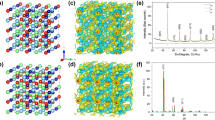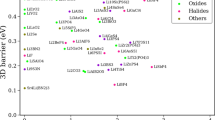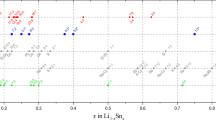Abstract
Data-driven methodology has become a key tool in computationally predicting material properties. Currently, these techniques are priced high due to computational requirements for generating sufficient training data for high-precision machine learning models. In this study, we present a support vector regression (SVR)-based machine learning model to predict the stability of silicon (Si)–alkaline metal alloys, with a strong emphasis on the transferability of the model to new silicon alloys with different electronic configurations and structures. We elaborate on the role of the structural descriptor in imparting transferability to the model that is trained on limited data (~ 750 Si alloys) derived from the Material Project database. Three popular descriptors, namely X-ray diffraction (XRD), sine coulomb matrix (SCM), and orbital field matrix (OFM), are evaluated for representing Si alloys. The material structures are represented by descriptors in the SVR model, coupled with hyperparameter tuning techniques like Grid Search CV and Bayesian optimization, to find the best performing model for predicting total energy, formation energy and packing fraction of the Si alloy systems. The models are trained on Si alloys with lithium (Li), sodium (Na), potassium (K), magnesium (Mg), calcium (Ca), and aluminum (Al) metals, where Si–Na and Si–Al systems are used as test structures. Our results show that XRD, an experimentally derived characterization of structures, performs most reliably as a descriptor for total energy prediction of new Si alloys. The study demonstrates that by qualitatively selection of training data, using hyperparameter tuning methods, and employing appropriate structural descriptors, the data requirements for robust and accurate ML models can be reduced.







Similar content being viewed by others
Data availability
The data, pre- and post-processing code reported in this paper are available on GitHub (https://github.com/joy1303125/Si-based-Material-stability-prediction).
References
Nishi Y (2001) Lithium ion secondary batteries; past 10 years and the future. J Power Sources 100(1–2):101–106. https://doi.org/10.1016/S0378-7753(01)00887-4
Shenoy VB, Johari P, Qi Y (2010) Elastic softening of amorphous and crystalline Li–Si phases with increasing Li concentration: a first-principles study. J Power Sources 195(19):6825–6830. https://doi.org/10.1016/j.jpowsour.2010.04.044
Limthongkul P, Jang YI, Dudney NJ, Chiang YM (2003) Electrochemically-driven solid-state amorphization in lithium–silicon alloys and implications for lithium storage. Acta Mater 51(4):1103–1113. https://doi.org/10.1016/S1359-6454(02)00514-1
Grosjean C, Herrera Miranda P, Perrin M, Poggi P (2012) Assessment of world lithium resources and consequences of their geographic distribution on the expected development of the electric vehicle industry. Renew Sustain Energy Rev 16(3):1735–1744. https://doi.org/10.1016/j.rser.2011.11.023
Kubota K, Dahbi M, Hosaka T, Kumakura S, Komaba S (2018) Towards K-ion and Na-ion batteries as “beyond Li-ion.” Chem Rec 18(4):459–479. https://doi.org/10.1002/tcr.201700057
Arrieta U, Katcho NA, Arcelus O, Carrasco J (2017) First-principles study of sodium intercalation in crystalline naxSi24 (0 ≤ x ≤ 4) as anode material for Na-ion batteries. Sci Rep 7(1):1–8. https://doi.org/10.1038/s41598-017-05629-x
Legrain F, Malyi OI, Manzhos S (2014) Comparative computational study of the energetics of Li, Na, and Mg storage in amorphous and crystalline silicon. Comput Mater Sci 94:214–217. https://doi.org/10.1016/j.commatsci.2014.04.010
Ponrouch A, Tchitchekova D, Frontera C, Bardé F, Arroyo-de Dompablo ME, Palacín MR (2016) Assessing Si-based anodes for Ca-ion batteries: electrochemical decalciation of CaSi2. Electrochem Commun 66:75–78. https://doi.org/10.1016/j.elecom.2016.03.004
Zhang D, Fu J, Wang Z, Wang L, Corsi JS, Detsi E (2020) Perspective—reversible magnesium storage in silicon: an ongoing challenge. J Electrochem Soc 167(5):050514-050519. https://doi.org/10.1149/1945-7111/ab736b
Beaulieu LY, Hatchard TD, Bonakdarpour A, Fleischauer MD, Dahn JR, Soc JE, A-a P, Beaulieu LY, Hatchard TD, Bonakdarpour A, Fleischauer MD (2003) Reaction of Li with alloy thin films studied by in situ AFM service reaction of Li with alloy thin films studied by in situ AFM. J Electrochem Soc 150(11):A1457. https://doi.org/10.1149/1.1613668
Lee S, Lee J, Chung S, Lee H, Lee S, Baik H (2001) Stress effect on cycle properties of the silicon thin-film anode. J Power Sources 97:191–193
Wang W, Kumta PN (2007) Reversible high capacity nanocomposite anodes of Si/C/SWNTs for rechargeable Li-ion batteries. J Power Sources 172:650–658. https://doi.org/10.1016/j.jpowsour.2007.05.025
Kim H, Chou C, Ekerdt JG, Hwang GS (2011) Structure and properties of Li–Si alloys: a first-principles study. J Phys Chem C 115:2514–2521
Wan W, Zhang Q, Cui Y, Wang E (2010) First principles study of lithium insertion in bulk silicon. J Phys Condens Matter 22(41):415501-415510. https://doi.org/10.1088/0953-8984/22/41/415501
Chevrier VL, Zwanziger JW, Dahn JR (2010) First principles study of Li–Si crystalline phases: charge transfer, electronic structure, and lattice vibrations. J Alloys Compd 496(1–2):25–36. https://doi.org/10.1016/j.jallcom.2010.01.142
Chiang HH, Lu JM, Kuo CL (2016) First-principles study of the structural and dynamic properties of the liquid and amorphous Li–Si alloys. J Chem Phys 144(3):034502-034512. https://doi.org/10.1063/1.4939716
Fan F, Huang S, Yang H, Raju M (2013) Mechanical properties of amorphous LixSi alloys: a reactive force field study. Model Simul Mater Sci Eng 21:074002. https://doi.org/10.1088/0965-0393/21/7/074002
Johari P, Qi Y, Shenoy VB (2011) The mixing mechanism during lithiation of Si negative electrode in Li-ion batteries: an ab initio molecular dynamics study. Nano Lett 11(12):5494–5500
Lee S, Ko M, Jung SC, Han YK (2020) Silicon as the anode material for multivalent-ion batteries: a first-principles dynamics study. ACS Appl Mater Interfaces 12(50):55746–55755. https://doi.org/10.1021/acsami.0c13312
Niu J, Zhang Z, Aurbach D (2020) Alloy anode materials for rechargeable Mg ion batteries. Adv Energy Mater 10(23):2000697
Mandal S, Haule K, Rabe KM, Vanderbilt D (2019) Systematic beyond-DFT study of binary transition metal oxides. npj Comput Mater 5(1):1–8
Li W, Walther CFJ, Kuc A, Heine T (2013) Density functional theory and beyond for band-gap screening: performance for transition-metal oxides and dichalcogenides. J Chem Theory Comput 9(7):2950–2958
Olson J, Priester M, Luo J, Chopra S, Zieve RJ (2005) Packing fractions and maximum angles of stability of granular materials. Phys Rev E Stat Nonlinear Soft Matter Phys 72(3):1–6. https://doi.org/10.1103/PhysRevE.72.031302
He Q, Yu B, Li Z, Zhao Y (2019) Density functional theory for battery materials. Energy Environ Mater 2(4):264–279
Deringer VL (2020) Modelling and understanding battery materials with machine-learning-driven atomistic simulations. J Phys Energy 2:041003-041011
Deringer VL, Bernstein N, Bartók AP, Cliffe MJ, Kerber RN, Marbella LE, Grey CP, Elliott SR, Csányi G (2018) Realistic atomistic structure of amorphous silicon from machine-learning-driven molecular dynamics. J Phys Chem Lett 9(11):2879–2885. https://doi.org/10.1021/acs.jpclett.8b00902
He X, Zhu Y, Epstein A, Mo Y (2018) Statistical variances of diffusional properties from ab initio molecular dynamics simulations. npj Comput Mater 4(1):1–9
Xie T, Grossman JC (2018) Crystal graph convolutional neural networks for an accurate and interpretable prediction of material properties. Phys Rev Lett 120(14):145301-145306. https://doi.org/10.1103/PhysRevLett.120.145301
Sanyal S, Balachandran J, Yadati N, Kumar A, Rajagopalan P, Sanyal S, Talukdar P (2018) MT-CGCNN: integrating crystal graph convolutional neural network with multitask learning for material property prediction, https://doi.org/10.48550/arXiv.1811.05660
Karamad M, Magar R, Shi Y, Siahrostami S, Gates ID, Farimani AB (2020) Orbital graph convolutional neural network for material property prediction. Phys Rev Mater 4(9):93801
Laws KJ, Miracle DB, Ferry M (2015) A predictive structural model for bulk metallic glasses. Nat Commun 6:8123. https://doi.org/10.1038/ncomms9123
Zeng S, Zhao Y, Li G, Wang R, Wang X, Ni J (2019) Atom table convolutional neural networks for an accurate prediction of compounds properties. npj Comput Mater 5(1):1–7. https://doi.org/10.1038/s41524-019-0223-y
Bartel CJ, Trewartha A, Wang Q, Dunn A, Jain A, Ceder G (2020) A critical examination of compound stability predictions from machine-learned formation energies. npj Comput Mater 6(1):1–11. https://doi.org/10.1038/s41524-020-00362-y
Natarajan AR, Van der Ven A (2018) Machine-learning the configurational energy of multicomponent crystalline solids. npj Comput Mater 4(1):1–7. https://doi.org/10.1038/s41524-018-0110-y
Kirklin S, Saal JE, Meredig B, Thompson A, Doak JW, Aykol M, Rühl S, Wolverton C (2015) The open quantum materials database (OQMD): assessing the accuracy of DFT formation energies. npj Comput Mater 1:1–15. https://doi.org/10.1038/npjcompumats.2015.10
Shapeev AV (2016) Moment tensor potentials: a class of systematically improvable interatomic potentials. Multiscale Model Simul 14(3):1153–1173
Bartók AP, Payne MC, Kondor R, Csányi G (2010) Gaussian approximation potentials: the accuracy of quantum mechanics, without the electrons. Phys Rev Lett 104(13):136403
Fujikake S, Deringer VL, Lee TH, Krynski M, Elliott SR, Csányi G (2018) Gaussian approximation potential modeling of lithium intercalation in carbon nanostructures. J Chem Phys 148(24):241714
Behler J, Parrinello M (2007) Generalized neural-network representation of high-dimensional potential-energy surfaces. Phys Rev Lett 98(14):146401
Zhang J, Lei Y-K, Zhang Z, Chang J, Li M, Han X, Yang L, Yang YI, Gao YQ (2020) A perspective on deep learning for molecular modeling and simulations. J Phys Chem A 124(34):6745–6763
Jiang D, Wu Z, Hsieh CY, Chen G, Liao B, Wang Z, Shen C, Cao D, Wu J, Hou T (2021) Could graph neural networks learn better molecular representation for drug discovery? A comparison study of descriptor-based and graph-based models. J Cheminform 13(1):1–23. https://doi.org/10.1186/s13321-020-00479-8
Faber FA, Hutchison L, Huang B, Gilmer J, Schoenholz SS, Dahl GE, Vinyals O, Kearnes S, Riley PF, Von Lilienfeld OA (2017) Prediction errors of molecular machine learning models lower than hybrid DFT error. J Chem Theory Comput 13(11):5255–5264
Yao K, Herr JE, Toth DW, Mckintyre R, Parkhill J (2018) The TensorMol-0.1 model chemistry: a neural network augmented with long-range physics. Chem Sci 9(8):2261–2269
Himanen L, Jäger MOJ, Morooka EV, Federici Canova F, Ranawat YS, Gao DZ, Rinke P, Foster AS (2020) DScribe: library of descriptors for machine learning in materials science. Comput Phys Commun 247:106949. https://doi.org/10.1016/j.cpc.2019.106949
Rupp M, Tkatchenko A, Müller KR, Von Lilienfeld OA (2012) Fast and accurate modeling of molecular atomization energies with machine learning. Phys Rev Lett 108(5):1–5. https://doi.org/10.1103/PhysRevLett.108.058301
Faber F, Lindmaa A, Von Lilienfeld OA, Armiento R (2015) Crystal structure representations for machine learning models of formation energies. Int J Quantum Chem 115(16):1094-1101. https://doi.org/10.1002/qua.24917
Behler J (2011) Atom-centered symmetry functions for constructing high-dimensional neural network potentials. J Chem Phys 134(7):74106
Bartók AP, Kondor R, Csányi G (2013) On representing chemical environments. Phys Rev B 87(18):184115
Pham TL, Kino H, Terakura K, Miyake T, Tsuda K (2017) Machine learning reveals orbital interaction in materials. Sci Technol Adv Mater 6996(November):1–2. https://doi.org/10.1080/14686996.2017.1378060
Jain A, Ong SP, Hautier G, Chen W, Richards WD, Dacek S, Cholia S, Gunter D, Skinner D, Ceder G (2013) Commentary: the materials project: a materials genome approach to accelerating materials innovation. APL Mater 1(1):11002
Saal JE, Kirklin S, Aykol M, Meredig B, Wolverton C (2013) Materials design and discovery with high-throughput density functional theory: the open quantum materials database (OQMD). Jom 65(11):1501–1509
Curtarolo S, Setyawan W, Hart GLW, Jahnatek M, Chepulskii RV, Taylor RH, Wang S, Xue J, Yang K, Levy O (2012) AFLOW: an automatic framework for high-throughput materials discovery. Comput Mater Sci 58:218–226
Bergerhoff G, Hundt R, Sievers R, Brown ID (1983) The inorganic crystal structure data base. J Chem Inf Comput Sci 23(2):66–69
Awad M, Khanna R (2015) Support vector regression. Efficient learning machines. Springer, p 67–80
Balabin RM, Lomakina EI (2011) Support vector machine regression (LS-SVM)—an alternative to artificial neural networks (ANNs) for the analysis of quantum chemistry data? Phys Chem Chem Phys 13(24):11710–11718
Kondati Natarajan S, Behler J (2017) Self-diffusion of surface defects at copper-water interfaces. J Phys Chem C 121(8):4368–4383
Behler J, Parrinello M (2007) Generalized neural-network representation of high-dimensional potential-energy surfaces. Phys Rev Lett 98(14):1–4. https://doi.org/10.1103/PhysRevLett.98.146401
Behler J (2021) Four generations of high-dimensional neural network potentials. Chem Rev 121(16):10037–10072
Graser J, Kauwe SK, Sparks TD (2018) Machine learning and energy minimization approaches for crystal structure predictions: a review and new horizons. Chem Mater 30(11):3601–3612
Jung H, Park M, Yoon Y-G, Kim G-B, Joo S-K (2003) Amorphous silicon anode for lithium-ion rechargeable batteries. J Power Sources 115(2):346–351
Ohara S, Suzuki J, Sekine K, Takamura T (2004) A Thin film silicon anode for Li-ion batteries having a very large specific capacity and long cycle life. J Power Sources 136(2):303–306
Chang KC, Nuhfer NT, Porter LM, Wahab Q (2000) High-carbon concentrations at the silicon dioxide-silicon carbide interface identified by electron energy loss spectroscopy. Appl Phys Lett 77(14):2186–2188. https://doi.org/10.1063/1.1314293
Pujahari RM (2021) Crystalline silicon solar cells, Elsevier. https://doi.org/10.1016/B978-0-12-823710-6.00004-2
Guha S, Yang J, Nath P, Hack M (1986) Enhancement of open circuit voltage in high efficiency amorphous silicon alloy solar cells. Appl Phys Lett 49(4):218–219. https://doi.org/10.1063/1.97176
Yanxon H, Zagaceta D, Wood BC, Zhu Q (2020) Neural network potential from bispectrum components: a case study on crystalline silicon. J Chem Phys 153(5):54118
Comin M, Lewis LJ (2019) Deep-learning approach to the structure of amorphous silicon. Phys Rev B 100(9):94107
Jain A, Hautier G, Moore CJ, Ping Ong S, Fischer CC, Mueller T, Persson KA, Ceder G (2011) A high-throughput infrastructure for density functional theory calculations. Comput Mater Sci 50(8):2295–2310. https://doi.org/10.1016/j.commatsci.2011.02.023
Peterson GGC, Brgoch J (2021) Materials discovery through machine learning formation energy. J Phys Energy 3(2):022002. https://doi.org/10.1088/2515-7655/abe425
Chen WC, Vohra YK, Chen CC (2022) Discovering superhard B-N-O compounds by iterative machine learning and evolutionary structure predictions. ACS Omega 7(24):21035–21042. https://doi.org/10.1021/acsomega.2c01818
Ward L, Dunn A, Faghaninia A, Zimmermann NER, Bajaj S, Wang Q, Montoya J, Chen J, Bystrom K, Dylla M, Chard K, Asta M, Persson KA, Snyder GJ, Foster I, Jain A (2018) Matminer: an open source toolkit for materials data mining. Comput Mater Sci 152(April):60–69. https://doi.org/10.1016/j.commatsci.2018.05.018
Ong SP, Richards WD, Jain A, Hautier G, Kocher M, Cholia S, Gunter D, Chevrier VL, Persson KA, Ceder G (2013) Python materials genomics (Pymatgen): a robust, open-source python library for materials analysis. Comput Mater Sci 68:314–319
Awad M, Khanna R (2005) Support vector regression. Effic Learn Mach 2007:67–80. https://doi.org/10.1007/978-1-4302-5990-9_4
Pedregosa F, Varoquaux G, Gramfort A, Michel V, Thirion B, Grisel O, Blondel M, Prettenhofer P, Weiss R, Dubourg V, Vanderplas J, Passos A, Cournapeau D, Brucher M, Perrot M, Duchesnay É (2011) Scikit-learn: machine learning in python. J Mach Learn Res 12:2825–2830
Waskom ML (2021) Seaborn: statistical data visualization. J Open Source Softw 6:3021
Aggarwal V, Gupta V, Singh P, Sharma K, Sharma N (2091) Detection of spatial outlier by using improved Z-score test. In: 2019 3rd international conference on trends in electronics and informatics (ICOEI). IEEE, pp 788–790
Kim S, Noh J, Gu GH, Aspuru-Guzik A, Jung Y (2020) Generative adversarial networks for crystal structure prediction. ACS Cent Sci 6(8):1412–1420
Cao Z, Dan Y, Xiong Z, Niu C, Li X, Qian S, Hu J (2019) Convolutional neural networks for crystal material property prediction using hybrid orbital-field matrix and magpie descriptors. Cryst 9(4):1-15 https://doi.org/10.3390/cryst9040191
Acknowledgements
The work is supported by National Science Foundation (NSF), Award Number # 2126180. Authors acknowledge Advanced Cyberinfrastructure Coordination Ecosystem: Service & Support (ACCESS) for the computational facilities (Award Number – DMR180013).
Author information
Authors and Affiliations
Contributions
VS and JK conceived the project. JK performed all work and wrote the manuscript with VS and DD. All authors approved the final version of the manuscript.
Corresponding author
Ethics declarations
Conflict of interest
The authors have no conflicts of interest to declare. All authors have seen and agree with the contents of the manuscript and there is no financial interest to report. We certify that the submission is original work and is not under review at any other publication.
Ethical approval
Not applicable.
Additional information
Handling Editor: Ghanshyam Pilania.
Publisher's Note
Springer Nature remains neutral with regard to jurisdictional claims in published maps and institutional affiliations.
Supplementary Information
Below is the link to the electronic supplementary material.
Rights and permissions
Springer Nature or its licensor (e.g. a society or other partner) holds exclusive rights to this article under a publishing agreement with the author(s) or other rightsholder(s); author self-archiving of the accepted manuscript version of this article is solely governed by the terms of such publishing agreement and applicable law.
About this article
Cite this article
Datta, J., Datta, D. & Sharma, V. Transferable and robust machine learning model for predicting stability of Si anodes for multivalent cation batteries. J Mater Sci 58, 11085–11099 (2023). https://doi.org/10.1007/s10853-023-08705-y
Received:
Accepted:
Published:
Issue Date:
DOI: https://doi.org/10.1007/s10853-023-08705-y




